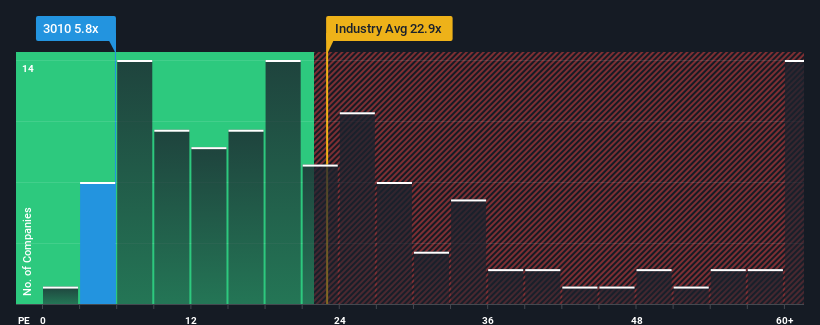- Japan
- /
- Hospitality
- /
- TSE:3010
Earnings Working Against Polaris Holdings Co., Ltd.'s (TSE:3010) Share Price Following 33% Dive
Unfortunately for some shareholders, the Polaris Holdings Co., Ltd. (TSE:3010) share price has dived 33% in the last thirty days, prolonging recent pain. Instead of being rewarded, shareholders who have already held through the last twelve months are now sitting on a 12% share price drop.
Even after such a large drop in price, given about half the companies in Japan have price-to-earnings ratios (or "P/E's") above 14x, you may still consider Polaris Holdings as a highly attractive investment with its 5.8x P/E ratio. However, the P/E might be quite low for a reason and it requires further investigation to determine if it's justified.
Recent times have been advantageous for Polaris Holdings as its earnings have been rising faster than most other companies. One possibility is that the P/E is low because investors think this strong earnings performance might be less impressive moving forward. If not, then existing shareholders have reason to be quite optimistic about the future direction of the share price.
See our latest analysis for Polaris Holdings

Is There Any Growth For Polaris Holdings?
There's an inherent assumption that a company should far underperform the market for P/E ratios like Polaris Holdings' to be considered reasonable.
Taking a look back first, we see that the company grew earnings per share by an impressive 440% last year. Although, its longer-term performance hasn't been as strong with three-year EPS growth being relatively non-existent overall. Accordingly, shareholders probably wouldn't have been overly satisfied with the unstable medium-term growth rates.
Shifting to the future, estimates from the sole analyst covering the company suggest earnings growth is heading into negative territory, declining 16% each year over the next three years. Meanwhile, the broader market is forecast to expand by 9.6% each year, which paints a poor picture.
In light of this, it's understandable that Polaris Holdings' P/E would sit below the majority of other companies. However, shrinking earnings are unlikely to lead to a stable P/E over the longer term. There's potential for the P/E to fall to even lower levels if the company doesn't improve its profitability.
What We Can Learn From Polaris Holdings' P/E?
Shares in Polaris Holdings have plummeted and its P/E is now low enough to touch the ground. It's argued the price-to-earnings ratio is an inferior measure of value within certain industries, but it can be a powerful business sentiment indicator.
We've established that Polaris Holdings maintains its low P/E on the weakness of its forecast for sliding earnings, as expected. At this stage investors feel the potential for an improvement in earnings isn't great enough to justify a higher P/E ratio. Unless these conditions improve, they will continue to form a barrier for the share price around these levels.
There are also other vital risk factors to consider and we've discovered 5 warning signs for Polaris Holdings (2 make us uncomfortable!) that you should be aware of before investing here.
If you're unsure about the strength of Polaris Holdings' business, why not explore our interactive list of stocks with solid business fundamentals for some other companies you may have missed.
New: Manage All Your Stock Portfolios in One Place
We've created the ultimate portfolio companion for stock investors, and it's free.
• Connect an unlimited number of Portfolios and see your total in one currency
• Be alerted to new Warning Signs or Risks via email or mobile
• Track the Fair Value of your stocks
Have feedback on this article? Concerned about the content? Get in touch with us directly. Alternatively, email editorial-team (at) simplywallst.com.
This article by Simply Wall St is general in nature. We provide commentary based on historical data and analyst forecasts only using an unbiased methodology and our articles are not intended to be financial advice. It does not constitute a recommendation to buy or sell any stock, and does not take account of your objectives, or your financial situation. We aim to bring you long-term focused analysis driven by fundamental data. Note that our analysis may not factor in the latest price-sensitive company announcements or qualitative material. Simply Wall St has no position in any stocks mentioned.
Have feedback on this article? Concerned about the content? Get in touch with us directly. Alternatively, email editorial-team@simplywallst.com
About TSE:3010
Good value with adequate balance sheet.
Similar Companies
Market Insights
Community Narratives




